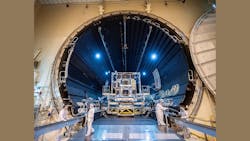If properly synchronized, satellite systems provide wide-ranging overviews of global missile activity. To ensure the highest performance even after logging long hours in space, Lockheed Martin used thermal vacuum (TVAC) testing at its Sunnyvale, CA satellite manufacturing facility to simulate the harsh environmental satellite operating conditions found in space. The testing was performed on the U.S. Space Force’s fifth space-based infrared system geosynchronous Earth orbit satellite (SBIRS), known as SBIRS GEO-5. The testing, performed in a depressurized enclosure (see the figure), simulated almost two months of satellite operation in space, on a satellite system based on a modern version of the company’s successful LM 2100 satellite bus.
The satellite uses infrared (IR) scanners and sensors for surveillance, notably to detect missile launches and help compute a ballistic response. The SBIRS GEO-5 satellite is one of many such scanning satellites and surveillance systems that provide continuous global coverage of terrestrial missile launches. Tucker White, SBIRS GEO-5 Assembly, Test, and Launch Operations Lead from Lockheed Martin’s Government Program Office, said: “The completion of TVAC can be attributed to a tremendous effort from the Air Force, Lockheed Martin, Aerospace Corporation, and supporting contractor teams.” He added: “The teams worked around the clock and finished on schedule to their original projection. This test phase is vital to any space vehicle test regime and takes GEO-5 one step closer to providing enhanced missile detection to our warfighters.”
Tom McCormick, vice-president for the Overhead Persistent Infrared (QPIR) Missions at Lockheed Martin Space, explained the importance of the IR sensors in space: “In SBIRS GEO-5, and our next satellite, GEO-6, we’re introducing game-changing enhancements to address the needs of our nation’s space warfighting force going forward.” McCormick pointed out the growing number of missile launches around the world: “The threat posed by ballistic missile technology continues to spread exponentially around the world. In 2019, SBIRS detected nearly a thousand missile launches globally, which is about a two-fold increase in two years.”
Lockheed Martin is the SBIRS prime contractor, working alongside Northrop Grumman Aerospace Systems (Azusa, CA).
About the Author
Jack Browne
Technical Contributor
Jack Browne, Technical Contributor, has worked in technical publishing for over 30 years. He managed the content and production of three technical journals while at the American Institute of Physics, including Medical Physics and the Journal of Vacuum Science & Technology. He has been a Publisher and Editor for Penton Media, started the firm’s Wireless Symposium & Exhibition trade show in 1993, and currently serves as Technical Contributor for that company's Microwaves & RF magazine. Browne, who holds a BS in Mathematics from City College of New York and BA degrees in English and Philosophy from Fordham University, is a member of the IEEE.
